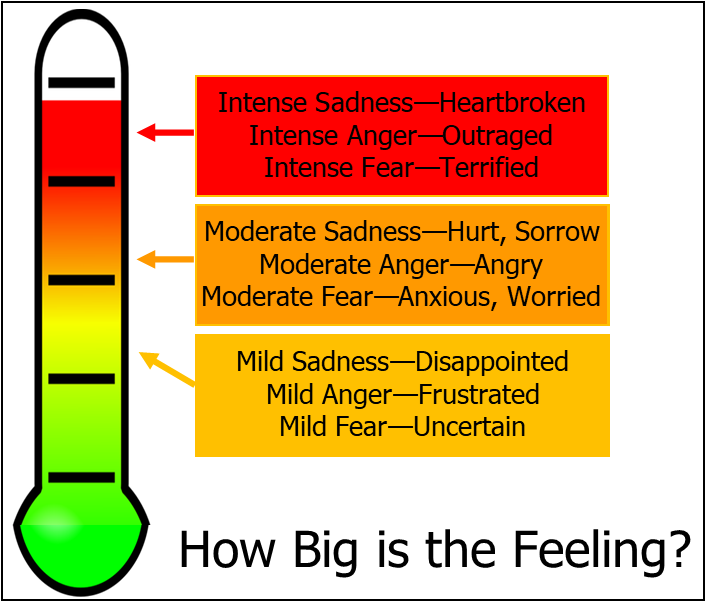I’ve written a lot about emotional development. This post is a brief summary of concepts, with links to learn more. We’ll cover: teaching vocabulary, teaching how to recognize emotions, teaching appropriate ways to express emotions (check out my printable posters!), and thinking about how big the emotion is, – if it’s small your child may be able to manage it – for big emotions, they’ll need your support.
Teaching Vocabulary
Children learn language for abstract concepts when we talk about those things as the child is experiencing them. When they are displaying an emotion (or they notice someone else is), we label it and talk about it. Knowing that emotions exist and having words for them is the first step to coping with those emotions. (Learn more about emotional literacy.)
The core basic emotions to start with are: mad, sad, glad, and scared. (And mad is often masking sad or scared feelings.) Babies demonstrate all these by 8 months. In the toddler years, they add in pride, envy, shame, guilt, and empathy. (Learn about emotional development.)
Teach How to Recognize Emotions
The next step is to teach them to recognize their own feelings and other people’s feelings. Teach about:
- body language
- facial expressions
- tone of voice
- actions
Tip: I have posters that include descriptions of these signs.
When your child is experiencing an emotion, tell them the signs you noticed so they notice them too: “I can tell you’re getting mad, because you’re banging that puzzle piece, and your eyebrows look angry.” When someone else is experiencing an emotion, help them identify that: “when you took your friend’s toy, that made him sad – he was crying and went for a snuggle with his daddy.”
You can read books that are aimed at teaching emotional literacy (here are my recommendations for children’s books about big feelings and more ideas on teaching emotional literacy using books). Or in ANY book or show, you can pause to notice feelings… “hmm, how do you think that character is feeling right now? how can you tell? what might help them feel better?”
When doing pretend play or things like puppet shows, role play emotions, including appropriate ways to express them and how to get support for them.
Learn more about helping your child to recognize feelings.
Teaching Appropriate Expression of Emotions
Children are going to have big feelings. They need to have a variety of tools for expressing them. Teach them good options during play time when they’re calm and suggest them when they’re having mild feelings. I have posters you can print and use.

Sometimes emotions can lead children to misbehave. Learn how to use emotion coaching to validate their feelings while still setting limits on behavior. And learn discipline tools for managing misbehavior. One key point I make is “all emotions are OK. Not all behaviors are.”
How Big is the Emotion?
It is helpful for you as the parent to understand different levels of emotion and what they mean for offering emotional support. As your child gets older (3 or older) you’ll start talking with them more about this as well.
There is a big difference between a child who is annoyed and one who is outraged. A big difference between disappointed and heartbroken. The thermometer metaphor can help us visualize this.

A child who is doing fine is cool and collected – green zone. As they start to feel frustrated, disappointed or uncertain, they’re moving into the yellow zone. As the feelings escalate bigger and bigger, they move to orange and red.
When a child is in the green zone, they’re ready to learn anything. This can be a good time to teach them coping skills and how to self-calm and let them practice them.

When a child is just starting to have feelings (yellow zone), they can often calm themselves. Today, I heard a child reassuring himself as he walked down some steep stairs – “hold the railing, it will be OK if I go slow.” I’ve seen kids getting frustrated stop and take a deep breath to calm down. These are self-calming skills they learned from their parents or teachers and they’re able to access them in these moments of mild upset.
When they are getting anxious, angry or hurt, (orange zone) they may be able to calm down if you coach them on using tools that you have been practicing.
When they are outraged, heartbroken or terrified, they are in the red zone. They have flipped their lid and are in their downstairs brain. (To learn more about what that means and how to handle it, check out this post on Meltdowns, learn more about preventing meltdowns and watch the video below on the Anatomy of a Tantrum to learn when to intervene and when to wait.) In the red zone, they can’t calm themselves without help.
Learn more about identifying how big the feelings are, and about the “zones of regulation” – a tool for helping a child (age 5 or older) learn how to identify their zone and what they might need to get back to the green zone: calm, cool, and ready to learn.